
MapStruct, a Java library for object mapping, enables bidirectional object mapping through mapper interfaces. It provides type safety, performance, and extensibility, eliminating the need for manual code generation, reducing errors, and optimizing pe

MapStruct Usage Tutorial
How to use mapstruct to map objects bi-directionally?
To map objects bi-directionally using MapStruct, you can create two mapper interfaces, one for each direction. For example:
<code class="java">@Mapper
public interface EntityToDtoMapper {
Dto map(Entity entity);
}
@Mapper
public interface DtoToEntityMapper {
Entity map(Dto dto);
}</code>Then, you can use these mappers to convert between the two objects:
<code class="java">Entity entity = Entity.builder().name("John Doe").age(30).build();
Dto dto = entityToDtoMapper.map(entity);
Entity newEntity = dtoToEntityMapper.map(dto);</code>What are the advantages of using mapstruct for object mapping in Java?
MapStruct offers several advantages for object mapping in Java, including:
How to create custom mappers using mapstruct?
To create custom mappers using MapStruct, you can use the @Mappings annotation to specify the custom mapping logic. For example:@Mappings annotation to specify the custom mapping logic. For example:
<code class="java">@Mapper
public interface EntityToDtoMapper {
@Mappings({
@Mapping(target = "dtoName", source = "entity.name"),
@Mapping(target = "dtoAge", source = "entity.age", qualifiedByName = "ageMapping")
})
Dto map(Entity entity);
@Named("ageMapping")
int mapAge(int age);
}</code>In this example, the ageMappingrrreee
ageMapping method is a custom mapping function that is used to convert the age from the entity to the DTO.🎜The above is the detailed content of mapstruct usage tutorial. For more information, please follow other related articles on the PHP Chinese website!




